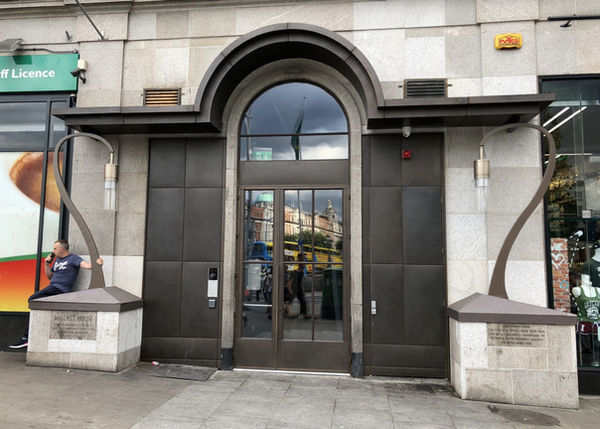Architectural Patination
Lambstongue Ltd.

Condition
Architectural bronze composed of copper, lead, iron and zinc provides greater strength and ductility than statutory bronze. It was widely used throughout the 20th century internally and externally in doors, windows, trimmings, rails and shopfronts. Like statutory bronze the surface of the metal could be coloured using artificial patination to provide an even and appealing finish. Newly fabricated bronze items as well as historic bronze required patination at Lambstongue Ltd.
Historic bronze was usually in a very stable condition. The natural oxidisation and wear of historic artificial patina would often contribute towards the appealing appearance of the bronze, though in some instances localised areas of more severe corrosion could result in uneven and undesirable finishes. Historic bronze that required structural repair, either through mechanical manipulation or welding would result in areas of abraded or exposed metal surface disrupting the patination finish. Newly fabricated bronze were constructed from pre-polished sheets and profiles.
Treatment Aim
To restore historic patination to an even and aesthetically appealing finish satisfactory to the client.
To artificially patinate profiles and large panels of new architectural bronze to the client’s specifications.
Treatment
Historic patination repair
The surface was cleaned with a damp cloth and mild detergent before softening and removal of any paint splashes using solvents.
Localised areas of corrosion to the bronze were mechanically pared back to match the rest of the finish using hand tools and a soft abrasive wheel. Use of chemical patination was sometimes used to even out the finish if needed.
A tinted microcrystalline wax was used for long term protection of the surface and guidance for maintenance and aftercare were produced for the client.
New fabricated bronze patination
The polished surface of the supplied architectural bronze required sandblasting in order to open the grain before patination. Due to residue staining the later patination finish, handling procedures were produced for staff to avoid contact with the surface to be patinated before and during treatment.
Two forms of patination were used depending on the size and shape of the item.
An immersion patination system was developed for creating an even finish to large panels.
Following sandblasting, a panel to be patinated was rinsed in a water bath to remove any residual particles. The panel was submerged in a 1% selenous acid solution and immersed for a set time depending on the shade required. It was again rinsed in the water bath immediately upon removal and dried using fine sawdust to avoid drip marks.
For thinner profiles where fluctuation in the finish were not so obvious a paste burnishing system was used. A paste was produced using an antimony sulphide powder and applied to the sandblasted metal surface with a paint brush. While the paste was still wet it was burnished into the metal using a fine gauge rotary wheel. This method could also be used for panel patination but was more labour intensive and required more skill to blend the finish well.
A tinted microcrystalline wax was used for long term protection of the surface and guidance for maintenance and aftercare were produced for the client.








